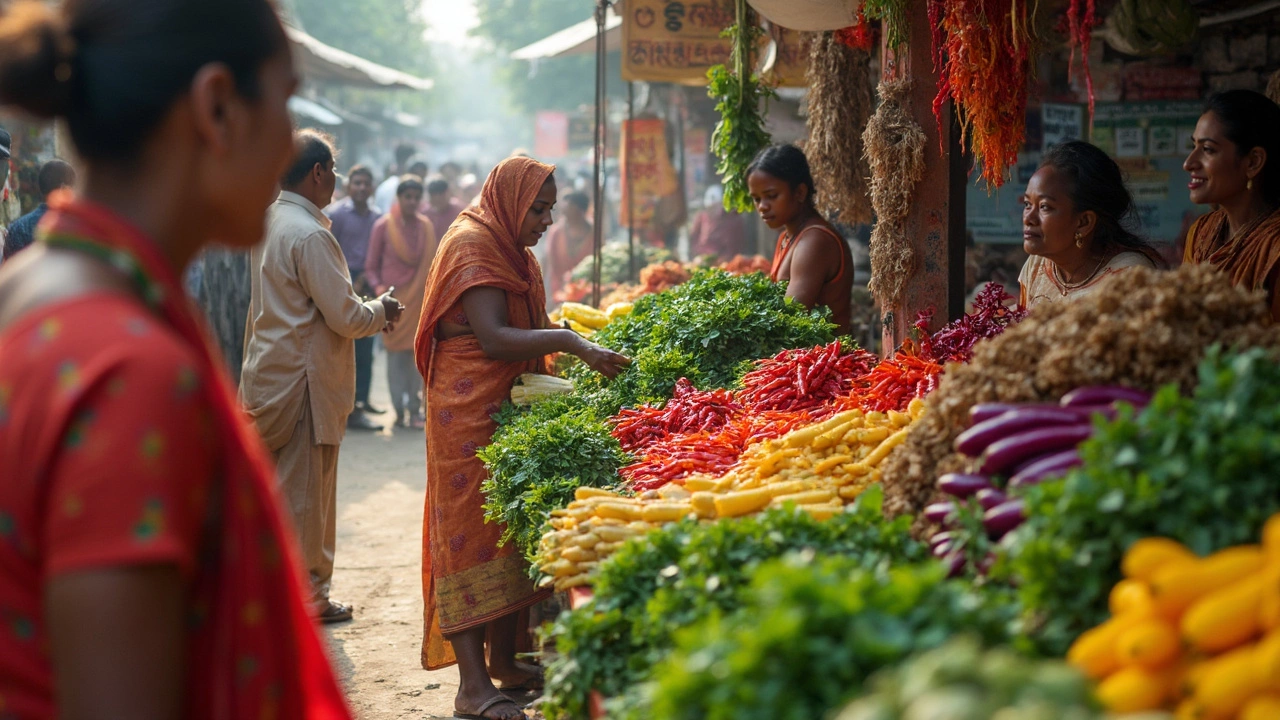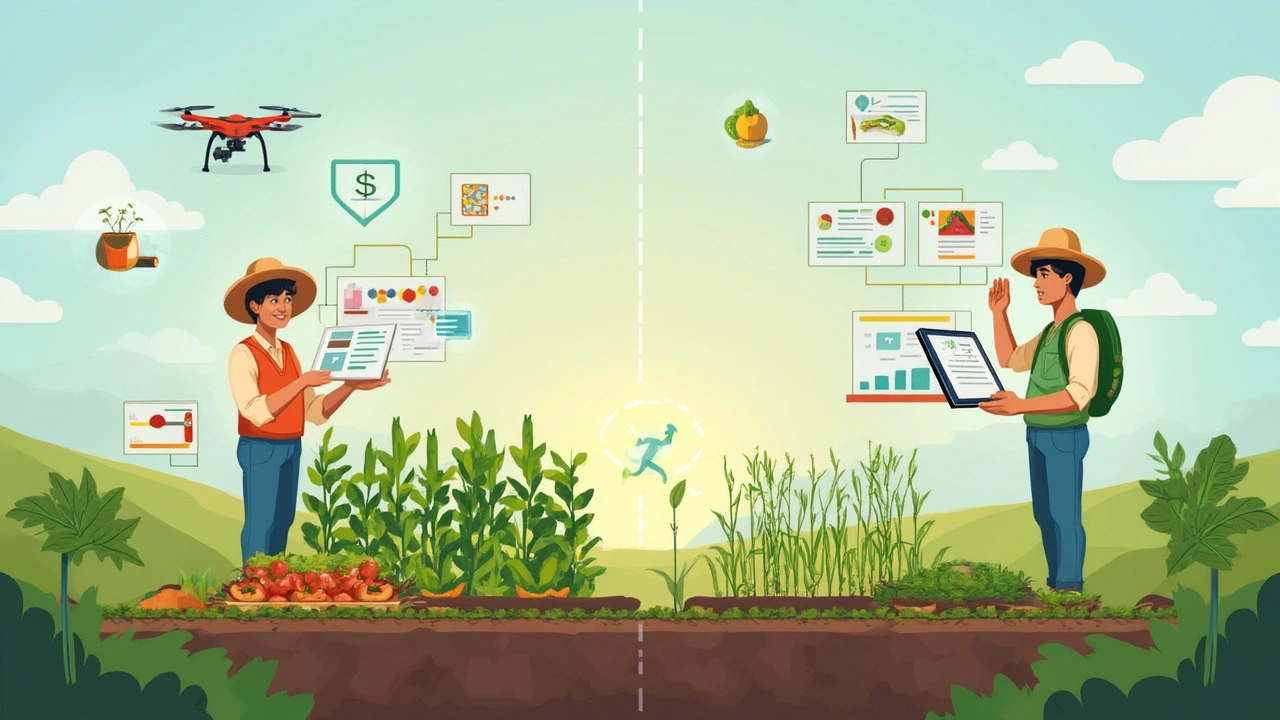Maximizing Profits with Vegetable Farming in India

If you're into vegetable farming in India, you might be wondering which crops bring home the most rupees. With a bit of strategy, you can reap major rewards from your efforts. Not all veggies are created equal when it comes to profits. The trick is knowing what to grow and how to manage your resources effectively.
Starting with the basics, crops like tomatoes, potatoes, and onions are staples in Indian diets and thus have a consistent demand. However, high-value crops such as bell peppers, broccoli, and exotic herbs can offer higher margins if you find the right market. It's about balancing staple crops with those that have potential for better profits.
But growing the right vegetables isn't the only part of the puzzle. Taking the time to understand market trends is crucial. Keeping an eye on seasonal demands and emerging preferences can give you a competitive edge. For example, there's been a rising interest in organic produce, and tapping into this segment could significantly boost your profits.
- Choosing the Most Profitable Vegetables
- Understanding Market Trends
- Organic Farming Techniques
- Resource Optimization
- Selling Strategies
Choosing the Most Profitable Vegetables
Picking the right veggies to grow can make all the difference in raking in profits. In India, vegetable farming isn't just about what you personally enjoy eating; it's about understanding market demand and climatic conditions specific to your region. It's smart to focus on crops that consistently bring in cash, such as tomatoes, potatoes, and onions, which are staples in Indian homes.
However, there is money to be made from lesser-grown, high-value crops too. Think exotic or gourmet vegetables like bell peppers, zucchini, broccoli, and cherry tomatoes. These are increasingly in demand in urban markets and can fetch higher prices.
Understanding Crop Demand
Before planting, research is crucial. Look into what's popular in your target market. For instance, if urban areas near you are seeing a rise in health-conscious consumers, there's likely a growing interest in fresh greens and organic produce. Keep your ear to the ground and gather insights from local markets or even online buyer communities.
High-Demand, High-Yield
Here's a quick tip: focus on crops that grow relatively quickly and offer multiple harvests within a year. This means more opportunities to make money, without waiting forever for a return. For example:
- Tomatoes: Offer good returns with multiple harvests and are always in demand.
- Leafy Greens: Lettuce and spinach mature fast and cater to health-focused consumers.
- Capsicum: Known for high market value and demand among culinary aficionados.
Consider a balanced approach where you mix staple crops with a few exotic choices. This strategy not only stabilizes your income but also opens doors for potential market expansion.
Understanding Costs and Benefits
Consider the input costs, like seeds and fertilizers, and compare them against expected returns. A smart farmer knows the way to maximum profit lies not only in what you sell but how much you spend to grow it.
| Vegetable | Estimated Yield (kg/hectare) | Average Market Price (Rs/kg) |
|---|---|---|
| Tomatoes | 50,000 | 15 |
| Broccoli | 20,000 | 60 |
| Onions | 40,000 | 12 |
There you go, a straightforward guide on selecting the right veggies to fatten your wallet through Indian agriculture. By focusing on both common and unique crops and keeping abreast of consumer trends, you can definitely make your vegetable farming highly profitable.
Understanding Market Trends
Navigating market trends is all about knowing what's hot and what's not. With agriculture profit hinging on these trends, it's crucial for farmers to stay updated. In India, the demand for vegetables can vary wildly, so being on top of these shifts can make a big difference in your vegetable farming success.
Seasonal Demand
First things first, understand the seasonal demand. For example, leafy greens like spinach and fenugreek are in high demand during winter, while gourds flourish in the summer markets. Timing your harvest with these demand spikes is key to fetching better prices.
Emerging Preferences
Considering modern dietary shifts, more Indians are opting for healthier, organic options. This means rising demand for vegetables like broccoli, kale, and bell peppers. By diversifying into these high-return crops, you're not just capitalizing on trends but also increasing your high yield crops roster.
Fluctuating Prices
Market prices can be volatile, influenced by everything from weather conditions to global trends. Keeping an eye on local mandis and online agricultural platforms helps in making informed decisions. You don't want to end up growing loads of a crop that suddenly loses its market value.
Technological Insights
Technology has stepped into the agricultural arena in a big way. Various apps now offer real-time data on current prices, best-selling crops, and even future predictions. Leveraging such tools can offer insights into maximizing your Indian crops profits effectively.
Here's a quick look at some recent price trends for popular vegetables:
| Vegetable | Average Price per Kg (INR) |
|---|---|
| Tomatoes | 20 |
| Onions | 50 |
| Broccoli | 80 |
| Bell Peppers | 100 |
Staying alert to these market nuances and adapting your farming strategy accordingly can help you keep those profits rolling. Remember, in Indian crops market, it's all about timing and trend-watching.

Organic Farming Techniques
Switching to organic farming isn't just about ditching chemicals; it's a whole mindset shift towards sustainable agriculture. It's rapidly becoming the talk of the town in Indian crops as folks are willing to pay a premium for chemical-free veggies. So, how do you start?
Soil Health and Preparation
The heart of any organic vegetable farm is its soil. Begin with soil testing to check its nutrient composition and pH levels. Use natural amendments like well-rotted manure or compost to enrich it. Healthy soil equals healthy plants and thus, more profits.
Natural Pest Control
Ditch the chemicals and embrace nature. Plant-friendly insects like ladybugs and spiders can keep harmful pests in check. Companion planting is another nifty trick—pairing certain plants together can actually repel bugs, saving you time and cash.
Crop Rotation and Diversity
Crop rotation isn't new, but it's vital in organic farming to prevent diseases and pests from getting too comfy. Rotate different vegetable families each season. Also, planting a variety of crops can increase biodiversity, improving your soil and yields.
Water Management
Being smart with water is crucial. Use drip irrigation systems to minimize waste and maximize efficiency. Mulching not only conserves water but also suppresses weeds and keeps your soil cooler.
Certifications and Market Access
Consider getting certified as an organic farmer to access niche markets. The process takes time but can open doors to higher selling prices and loyal customers.
| Technique | Profit Boost (%) |
|---|---|
| Soil Health Improvements | 20-30% |
| Natural Pest Control | 15-25% |
| Efficient Water Use | 10-15% |
By incorporating these techniques, you can boost your farm's profits and contribute to a healthier planet. Plus, connecting with your local community about the benefits of organic produce could increase demand even more.
Resource Optimization
Anyone trying to get the most out of vegetable farming needs to be smart about resource optimization. It's all about getting the best yield with the least costs possible. For starters, water management plays a huge role. India's got areas that face water scarcity, so efficient irrigation methods like drip or sprinkler systems can make a big difference here. These systems ensure that plants receive the right amount of water, saving on both money and water.
Efficient Use of Land
Land is a precious resource, and using it wisely can increase your agriculture profit. One way to do this is through crop rotation, which involves growing different crops in a sequenced manner on the same plot. This practice not only maximizes the use of nutrients in the soil but also improves soil health and controls pests and diseases, reducing reliance on chemical fertilizers and pesticides.
Embrace Technology
There's a constant need to keep up with the latest technology. From soil testing kits that analyze nutrient levels to smartphone apps that guide you through planting schedules, tech can help streamline many aspects of farming. Adopting technology can lead to more informed decision-making and less trial-and-error.
Fuel and Energy Savings
Reducing fuel costs should also be on your list. This can mean cutting down on unnecessary passes on the field with machinery or opting for solar-powered tools that reduce electricity bills. Some farmers are exploring solar panels to power irrigation pumps, a decision that pays off in the long run.
For our larger operations, here's a quick table to compare the costs:
| Resource | Traditional Methods (₹/month) | Optimized Methods (₹/month) |
|---|---|---|
| Water | 5,000 | 3,000 |
| Energy | 8,000 | 5,000 with solar |
| Labor | 10,000 | 7,000 |
Labor Management
Labor is another area where costs can spiral if not managed well. Training your workers in the best farming practices can lead to higher efficiency. Allocation of tasks based on skills ensures that every hand is working productively.
By focusing on these areas, not only do you cut costs, but you also boost overall returns from your vegetable farming ventures in India. Remember, a penny saved is a penny earned, especially in agriculture!

Selling Strategies
Now that you’ve harvested your crops, it’s time to think about how to sell them for the best return. A smart selling strategy can make a huge difference in your profit margins. Here's how you can maximize your returns.
Direct to Consumer Sales
One of the most effective ways to boost your income is by selling vegetable farming products directly to consumers. This could be through farmers' markets or even selling baskets of fresh produce to local homes. Not only do you cut out the middleman, but your customers get a fresher product too. Weekly subscription models are becoming popular, where families pay a set fee for regular deliveries of veggies.
Partner with Local Businesses
Restaurants, grocery stores, and co-ops can be great partners. Approach local establishments and offer them seasonally fresh, locally grown produce. High yield crops like bell peppers or tomatoes are always in demand. According to a quote by business magnate Ratan Tata, "Agriculture, done right, offers an area of great market potential." This rings particularly true when businesses want to promote local sourcing.
"Agri-preneurs who invest in local supply chains play a key role in economic growth." - Ratan Tata
Go Digital
Leverage technology by establishing an online presence. Use social media platforms to reach a larger audience and keep them updated on your products. Set up a simple website where customers can see what's in season and place orders. You'd be surprised at how much Indian crops can fetch when enthusiasts from urban areas want that farm-fresh touch.
Value Addition and Branding
Consider adding value to your produce. This could mean packaging your vegetables in eco-friendly wraps or even creating combos like "stir-fry packs" with a ready selection of ingredients. Branding your products gives them an identity that consumers can relate to and trust. It’s all about creating an experience people want to come back to.
Statistics to Keep in Mind
For a little context on market opportunities, here’s a simple table showing the growth in organic and local produce demand from 2022 to 2024:
| Year | Organic Produce Demand Growth | Local Produce Demand Growth |
|---|---|---|
| 2022 | 12% | 8% |
| 2023 | 15% | 10% |
| 2024 | 18% | 12% |
These numbers show a clear trend towards more sustainable choices, giving you the opportunity to position your agriculture profit business as the go-to for eco-friendly, fresh veggies.





